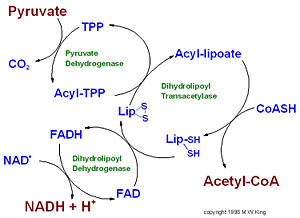Sandbox Reserved 647
From Proteopedia
| This Sandbox is Reserved from 30/08/2012, through 01/02/2013 for use in the course "Proteins and Molecular Mechanisms" taught by Robert B. Rose at the North Carolina State University, Raleigh, NC USA. This reservation includes Sandbox Reserved 636 through Sandbox Reserved 685. | ||||||||||||
To get started:
More help: Help:Editing For more help, look at this link: http://proteopedia.org/w/Help:Getting_Started_in_Proteopedia
Pyruvate dehydrogenase (E1) along with two other enzymes make up the multienzyme complex pyruvate dehydrogenase. Dihydrolipoyl transacetylase (E2) and dihydrolipoyl dehydrogenase (E3) are the other two main components of the complex. These enzymes work together to synthesize acetyl Co-A from pyruvate before entering the Kreb's cycle. The pyruvate dehydrogenase complex acts to link glycolysis to the citric acid cycle. Pyruvate dehydrogenase consists of a combination of beta strands and alpha helices. this is the site of between three residues of pyruvate dehydrogenase.
|

